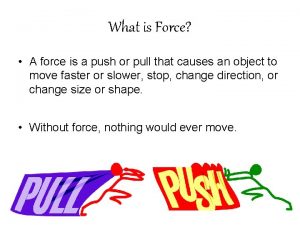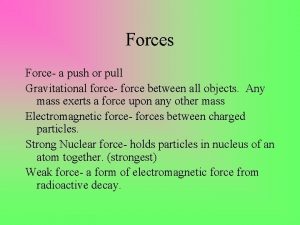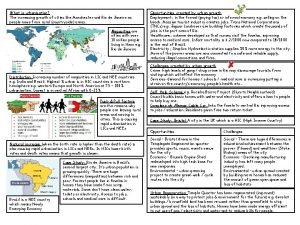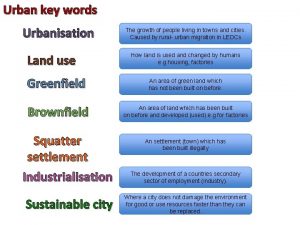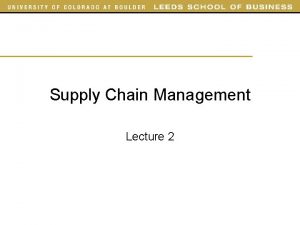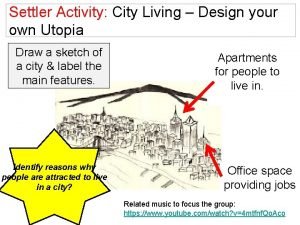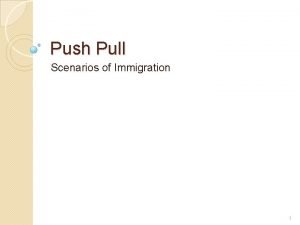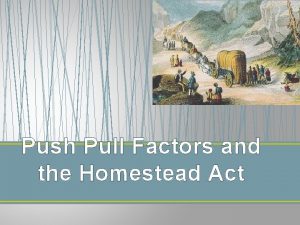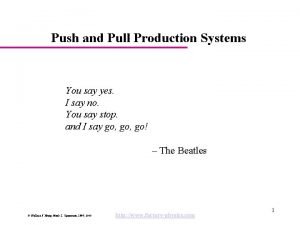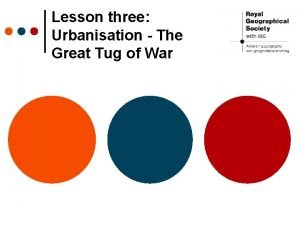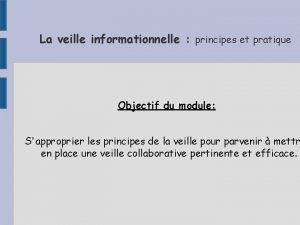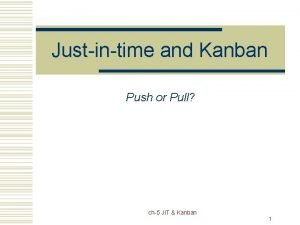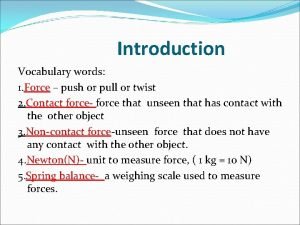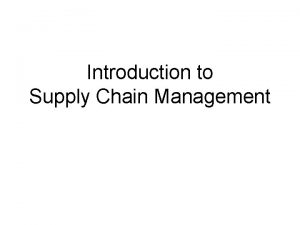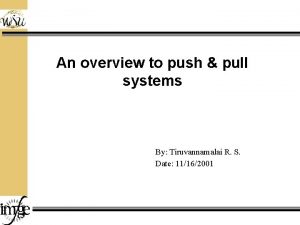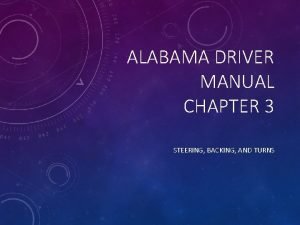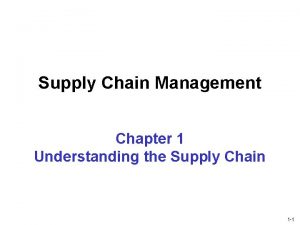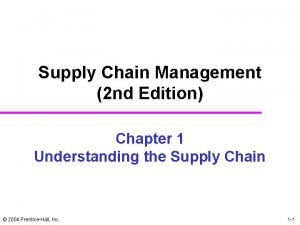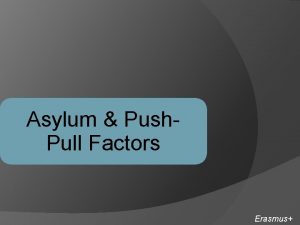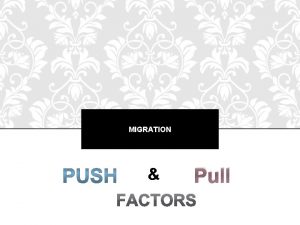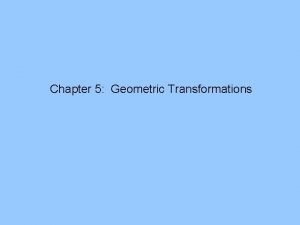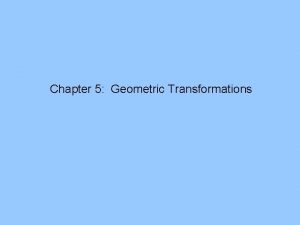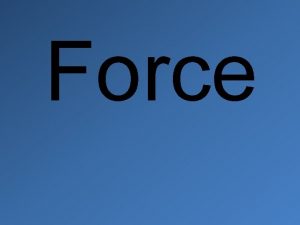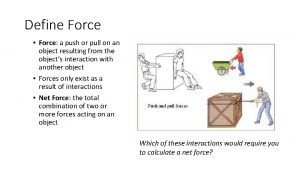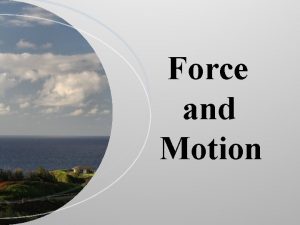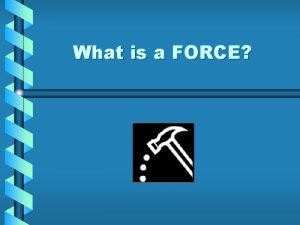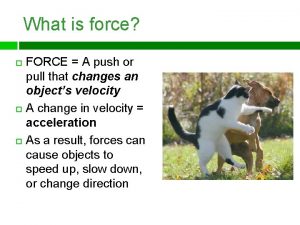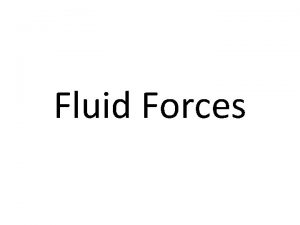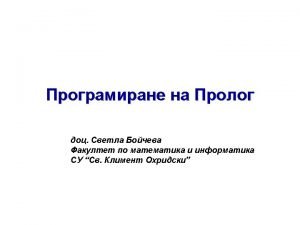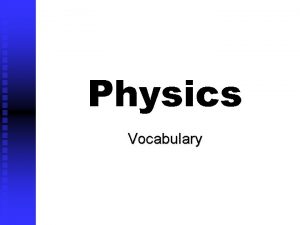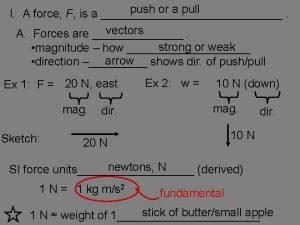Physics Unit 1 Force Force push or pull





























- Slides: 29

Physics Unit 1 Force

Force – push or pull • A force always acts in a certain direction • ex. if you push something, the force is in the direction of the push • To describe a force you need to know direction and strength (size) of the force • ex. Push the box to the right with a force greater than 20 N

Net force • Is the total force acting on an object • To find net force: • Add forces acting in the same direction • Subtract forces acting in opposite directions

Weight - Weight is a force - Weight is a measure of the amount of gravity acting on an object - To lift an object on Earth you must over come the gravity pulling on it, you must lift with a force equal to or greater than its weight

Newton • metric unit of force • named in honor of Sir Isaac Newton

What is gravity? • Sir Isaac Newton • 1642 – 1727 • The Law of Gravity or Universal Gravitation – states that all objects are attracted to each other by the force of gravity

Gravity • force of attraction between all objects in the universe

Gravity • the larger an object’s mass, the greater the gravitational force

Gravity • the greater the distance between two objects, the smaller the gravitational force • the force of gravity decreases by the amount equal to one divided by the distance (d) squared • 1/d 2

What is air resistance? • air resistance • force that opposes the movement of an object in air

Air Resistance • a larger surface area usually results in greater air resistance • lighter objects feel more air resistance than heavier objects

Terminal Velocity • speed at which air resistance and gravity acting on an object are equal • as an object falls, it’s speed increases at a steady rate until it reaches it’s terminal velocity

Vacuum – empty space • In a vacuum there is no air and no air resistance • in a vacuum, all objects fall at the same speed

What is friction? • Friction • force that opposes the motion of an object • the force of friction works in the opposite direction of the force of motion

Types of Friction • Sliding Friction • the source of friction is the contact between two surfaces, at least one of which is in motion

Types of Friction • Rolling Friction • friction between two surfaces that are not in constant contact • ex. wheels

Types of Friction • Fluid friction – friction that occurs when an objects move through a fluid; through a gas or liquid

Types of Friction • Air Resistance is a Type of Fluid Friction • friction results from air pushing on an object as it is moving

Types of Friction • Static friction – friction of an object at rest

Friction • friction makes motion possible • friction also makes it hard to move objects • reducing friction makes it easier to move objects

How can friction be reduced? • by changing sliding friction into rolling friction • by using lubricants • Lubricants – substances that reduce friction

Pressure • pressure is the amount of force acting on a surface

Pressure • pressure can be changed by changing the amount of force acting on an area • pressure can be changed by changing the area on which a force acts

Fluid Pressure • pressure in gases and liquids

Air Pressure • air pressure is caused by the motion of particles in the air • you do not feel the weight of the air because the pressure inside your body is equal to the air pressure around you

Air Pressure • air pressure changes with altitude • the higher you are, the lower the air pressure

What is Bernoulli’s principle? • Bernoulli’s Principle • principle that states that as the speed of a fluid increases, its pressure decreases

Bernoulli’s Principle • airplane wings are designed to use Bernoulli’s principle • air traveling over the wings moves faster than air underneath • this reduces the pressure on top of the wing, allowing it to be pushed upward

Bernoulli’s Principle • three forces combine to help an airplane fly • the upward force on a plane’s wing is called lift • a forward force, or thrust, helps the plane take off and maintain air speed • the air resistance on a plane is called drag
 Magnetic force push or pull
Magnetic force push or pull Gravitational force push or pull
Gravitational force push or pull Pull angle
Pull angle Push and pull factors of urbanisation
Push and pull factors of urbanisation Push and pull factors of urbanisation
Push and pull factors of urbanisation Push and pull factors of urbanisation
Push and pull factors of urbanisation Curitiba sustainable city
Curitiba sustainable city Push pull in supply chain
Push pull in supply chain Strategie promocji
Strategie promocji Your
Your Push and pull scenarios
Push and pull scenarios Push factor definition
Push factor definition Conwip
Conwip Carefully blended mix of promotion tools
Carefully blended mix of promotion tools Marketing objectives examples
Marketing objectives examples Push pull profile strategies marketing communications
Push pull profile strategies marketing communications What is an example of market pull
What is an example of market pull Push and pull factors of urbanisation
Push and pull factors of urbanisation Pull push
Pull push Methode pull
Methode pull Oros push pull
Oros push pull Définition veille informationnelle
Définition veille informationnelle Jit push or pull
Jit push or pull Push and pull vocabulary
Push and pull vocabulary Replenishment cycle in supply chain
Replenishment cycle in supply chain Influencing styles
Influencing styles Push and pull
Push and pull Alabama driver manual
Alabama driver manual Supply chain cycle
Supply chain cycle Describe the cycle and push/pull views of a supply chain
Describe the cycle and push/pull views of a supply chain
